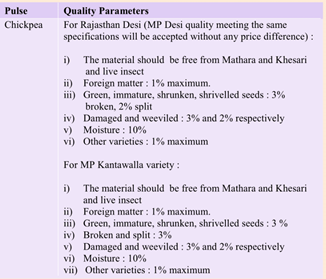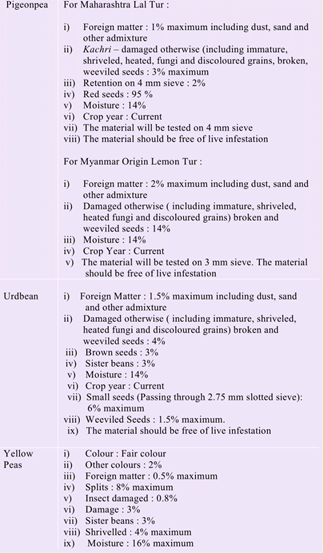Quality standards of marketable pulses
Quality standards of marketable pulses
Pulses are marketed as a raw whole as well as dehusked split. For marketing of pulses, quality of product becomes of prime importance. Cleaned and well-graded whole grains fetch higher prices. For dehusked splits, better packaging is required to reduce post-milling losses and to increase acceptability of consumers.
Quality standards
Quality specifications pulse grains
In order that commercial transactions can proceed properly and to the complete satisfaction of both sellers and buyers, realistic and practical legal standards should be adopted that clearly stipulate product quality, methods of ascertaining it, and marketing standards. Application of such norms is influenced by the degree of training for workers concerned with quality control and by the availability of specific equipment.
Based upon the requirement of trade and industry, quality standards have been developed for different pulses. These standards for some of the pulses are shown in the following table


Packaging
Deterioration and losses of products, during transport and storage depend upon a series of physical, chemical, biological and human factors. Proper packaging is an important element in reducing losses, especially in the tropics. Climate considerably increases the risks of grain deterioration. The main functions of packaging are:
- to permit easy handling, whether manual or mechanical • to reduce product losses by theft
- to protect the product from external attack (by humidity, insects, sunlight, etc.)
There are various types of packaging for agricultural commodities, appropriate to the product characteristics and to the marketing system. Woven bags made of plant or plastic fibers are the usual type used for grains. Reasonably priced bags, which fulfill the functions described above, can normally be made from such fibers. The choice of the type of bag should taken into account not only its inherent toughness and resistance to humidity, sunlight and pests but also the type of handling anticipated.
Plant fibre bags
A number of plant fibres like jute, cotton, and sisal are used for making bags for packaging of pulse grains. The choice of packaging material depends upon packaging requirement.
Jute bags: The jute bag is the most widely used packaging material in the world. It combines good resistance capacities with a relatively moderate cost. It can be re-used several times since it has good inherent toughness, which reduces the risks of tearing. In addition, it protects the grain effectively from sunlight. However, with its relatively heavy fibre with a coarse texture makes it inappropriate for small-size grains. Furthermore, jute easily absorbs humidity and offers little resistance to the attacks of insects and rodents. In order to partially offset the disadvantages of humidity absorption, these bags can be lined with plastic or, if necessary, covered with waterproof tarpaulins. Handling jute bags is easy because the material is not slippery. As a result, fairly high stacks can be erected.
Cotton bags : The cotton bag is used for packaging value-added products obtained after processing, such as flours or sugar. Actually its features are practically the same as those of jute, except that the cotton bag is lighter, harder to sew, and more costly.
Sisal bags: The sisal bag is rougher than the other plant-fiber bags and is seldom used except in sisal producing countries like Mexico, Brazil and some African countries. Its features are comparable to those of jute bags.
Paper bags: They are more vulnerable and require more delicate handling. They offer very little protection against humidity and insects, and must be stored under good conditions. They are used especially for packaging seeds.
As for the other plant fibers, hemp and linen, they are virtually no longer used for bags because of their high costs.
Plastic fibre bags
PP woven bags : These bags are made of plastic (polythene) woven fabrics, or of mixed fabrics (plant fiber and plastic fiber). Polythene bags are widely used for packaging grains and they seriously rival the traditional jute bag. These bags have the advantage of being resistant to moisture transfer, rot-proof, and impermeable to insect pests. However, they should be suitably treated in order to resist sunlight, since polythene deteriorates when exposed to light. With good treatment, a polythene bag can be reused for 6-12 times. They cost less than jute bags and are harder to handle. Their surface is very slippery, and so they cannot be stacked very high.
Polyethylene bags : The most commonly used material for such bags is polyethylene and polyester. These bags are not moisture-proof but are moisture resistant. They deteriorate easily if exposed to sunlight, therefore, should be protected from direct sunlight. They are difficult to stack as bags may slide and fall down).
Type and size of the bags
The choice of bags invariably depends on the material to be packed. The size of bags should take into consideration
- The amount of material required by the consumers
- The average men's capability to carry it during loading or unloading
- Ease in handling by the consumers during transport
In general, jute, cloth and pp woven bags are used for packaging of pulse grains in bulk in sizes of 50 kg or 100 kg. Polyethylene bags are preferred for packing of pulse grains and value added products for retail trade. Size of these packages may vary from 500 g to 5 kg. In any case, the bags should be :
- Easy to handle, transport and store
- Strong enough to avoid losses and to protect against mechanical damage.
Adulteration in pulses
What is adulteration?
Pulses in the diet acts as a fuel for body and mind to keep it fit and working. Many times pulses purchased from the market are either adulterated with khesari (Lathyrus) dal or some low-priced dals or are coloured with some undesirable colours to improve its appearance, which are harmful for the health. With high degree of sophistication in method of adulteration, it becomes imperative that pulses to be consumed should be pure and wholesome. A common consumer may not have sufficient knowledge about the impurity and quality of the pulses. Awareness about necessary means to verify or test its quality is also lacking. Mere visual inspection does not serve purpose. Consumer awareness is the remedy for eliminating this evil of adulteration and sale of sub-standard product.
Test for adulteration
Some simple and quick tests are available which can be easily performed to ascertain the purity of dal or besan if it is adulterated with khesari (Lathyrus) dal or the presence of some harmful chemicals in the form of colouring agent. The available tests are given as under :

Source: Indian Institute of Pulses Research
आख़िर बदलाउ कयल : 3/1/2020
Provides information about मेरा अस्पताल (My Hospit...
This topic provides the information about the Adul...
This topic provides information about cultivation ...
